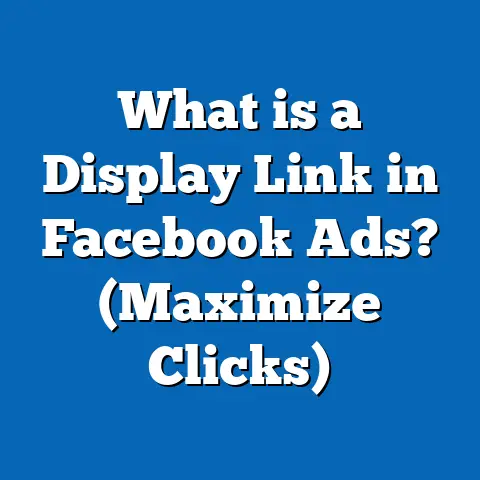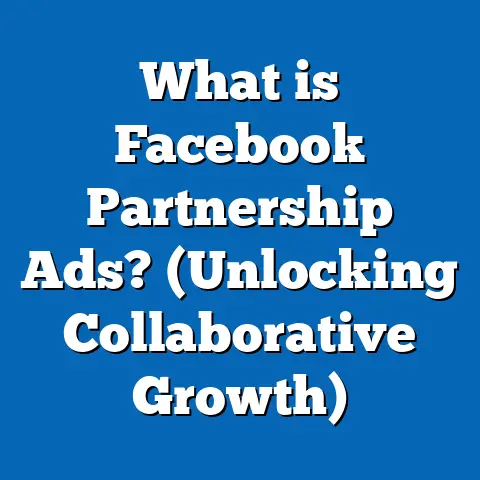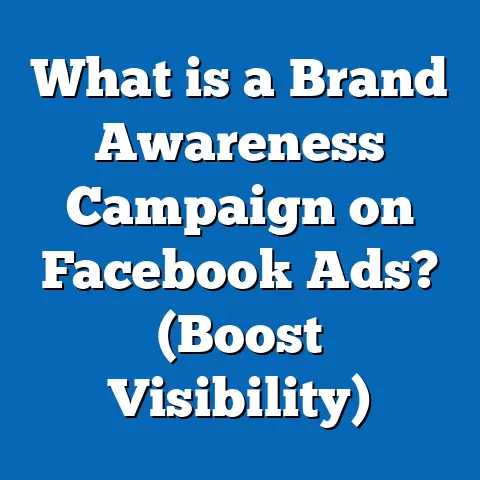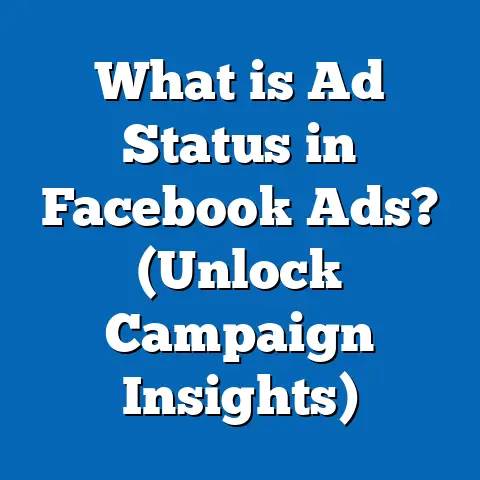What is Facebook Collaborative Ads? (Unlock Shared Success)
Introduction: The Hidden Power Behind Retail Growth
Imagine a world where brands and retailers no longer compete for digital attention but join forces, amplifying each other’s reach and sales. Now, consider that this approach isn’t just theory—it’s reshaping how products are advertised and sold on Facebook, one of the world’s largest social platforms. As you read on, you’ll uncover the mechanics behind Facebook Collaborative Ads, a solution quietly powering some of the most successful partnerships in digital advertising today. Why are global brands and nimble startups alike racing to adopt it? What sets it apart from traditional Facebook ads or retail media? The answer could redefine your next marketing strategy.
What Are Facebook Collaborative Ads?
Defining Collaborative Ads
Facebook Collaborative Ads (CAs) are a specialized ad format that allows brands (manufacturers or suppliers) to run direct-to-consumer ad campaigns, driving traffic and sales to their retail partners’ online stores. Instead of selling directly, brands can target Facebook and Instagram users with ads that seamlessly direct them to purchase through approved retailer websites or apps.
How It Works
- Retailers set up a product catalog on Facebook and share a segment with brand partners.
- Brands receive access to these catalog segments, enabling them to create ads that showcase retailer inventory.
- Shoppers see personalized ads and, with a single click, are sent to the retailer’s product page for purchase.
Why Collaborative Ads Matter Now
The Shift in Shopper Behavior
- 71% of consumers are more likely to purchase from an ad if it takes them directly to a trusted retailer (Meta Internal Data, 2023).
- 65% of global shoppers prefer to buy from multi-brand retailers rather than brand-owned webshops (Statista, 2022).
Challenges Traditional Models Face
- Brands often lack visibility into retailer inventory or customer behavior.
- Retailers struggle to co-market with brands efficiently at scale.
- Direct-to-consumer models can alienate retail partners or confuse customers.
Collaborative Ads offer a win-win: brands drive sales and gain insights, while retailers benefit from increased traffic and conversion rates.
Breaking Down the Mechanics
The Players: Brands and Retailers
Brands: Manufacturers, suppliers, or CPG companies wanting to promote products but lacking direct e-commerce infrastructure.
Retailers: Online stores or apps (think Amazon, Walmart, Carrefour, Flipkart) that sell third-party products and want more partners sending shoppers their way.
The Technical Flow
- Catalog Sharing: Retailers upload their product feed to Facebook Commerce Manager, then share segments (i.e., specific brands or categories) with partners.
- Ad Creation: Brands access this shared catalog data in their own ad accounts using Meta Ads Manager.
- Campaign Launch: Brands run ads targeting specific audiences, driving clicks directly to retailer product pages.
- Measurement & Optimization: Brands track performance through event data (e.g., add-to-cart, purchase) shared by retailers via the Facebook pixel or SDK.
Key Features and Benefits
For Brands
- Seamless Campaigns: Launch campaigns without building checkout infrastructure.
- Granular Insights: Access reporting on clicks, conversions, and ROAS (return on ad spend).
- Flexible Targeting: Leverage Facebook’s powerful audience tools—Custom Audiences, Lookalikes, interest-based targeting.
For Retailers
- Incremental Sales: Gain new traffic from brand campaigns.
- Data Control: Share only relevant catalog segments and control access.
- No Extra Tech Overhead: Integration uses existing Facebook Commerce Manager setup.
For Shoppers
- Frictionless Experience: See relevant ads and buy from known retailers in one click.
Data & Performance Insights
Industry Benchmarks
- Brands using Collaborative Ads have seen up to 30% higher conversion rates compared to traditional awareness campaigns (Meta Business Case Studies, 2023).
- ROAS lifts of 1.5x to 2x have been reported when CAs are integrated with dynamic retargeting strategies (Accenture/Meta Whitepaper, 2022).
- On average, 60% of shoppers exposed to CAs complete their purchases within 24 hours (Meta Internal Analysis).
Case Study: Adidas x JD Sports
The Setup
Adidas wanted to boost sales of its latest sneaker line via JD Sports’ website. Using Collaborative Ads:
- JD Sports shared a filtered catalog (Adidas only) with the Adidas marketing team.
- Adidas ran dynamic product ads on Facebook and Instagram targeting sneaker fans in the UK.
- All ad clicks led directly to JD Sports’ product pages.
The Results
- 25% increase in click-through rate (CTR) compared to Adidas’ previous direct-to-site campaigns.
- 20% growth in conversion rate for JD Sports on Adidas products.
- Shared reporting enabled both partners to optimize bids and creative daily.
Step-by-Step Guide: Setting Up Collaborative Ads
1. Retailer Onboarding
- Register as a retailer on Meta Commerce Manager.
- Upload your full product catalog, ensuring high-quality images and accurate inventory data.
2. Catalog Segmentation & Sharing
- Segment your catalog by brand, category, or other filters as needed.
- Share specific segments with approved brand partners via Commerce Manager.
3. Brand Access & Campaign Planning
- Accept the catalog share request in your Meta Business Suite.
- Plan campaigns using available catalog products; set objectives (traffic, conversions).
4. Ad Creation & Targeting
- Use Dynamic Ads format for personalized product recommendations.
- Target using Custom Audiences (e.g., past website visitors), Lookalike Audiences, or demographic/interest filters.
5. Measurement & Optimization
- Use Meta Pixel or SDK integration for granular conversion tracking.
- Analyze results; optimize creative, bidding, and targeting for best performance.
Advanced Tactics for Maximum Impact
Dynamic Product Ads (DPA)
Pairing Collaborative Ads with DPA allows for highly personalized recommendations based on user behavior—showing shoppers products they browsed or abandoned in cart at retailer sites.
Cross-Retailer Campaigns
Brands can run parallel campaigns across multiple retailers simultaneously—testing which partners drive higher ROI and reallocating budget accordingly.
Omnichannel Integrations
Combine CAs with offline to online tracking (using Meta’s Offline Events) to measure in-store sales resulting from digital campaigns.
Practical Examples Across Industries
FMCG & CPG Brands
A beverage company partners with multiple grocers—driving shoppers from Facebook ads straight to the beverage’s product page on Kroger, Tesco, and Walmart’s sites. Each campaign is tailored for local pricing and inventory.
Consumer Electronics
A smartphone brand uses CAs to highlight its latest model at top electronics retailers. Shoppers see ads linking directly to Best Buy or MediaMarkt’s checkout page—whichever is nearest or preferred.
Fashion & Apparel
Apparel brands run time-limited promotions (like Black Friday deals) via collaborative ads with retail chains, dynamically adjusting creative as inventory changes.
Comparison: Collaborative Ads vs Traditional Facebook Ad Formats
| Feature | Collaborative Ads | Standard Facebook Ads |
|---|---|---|
| Destination | Retailer’s e-commerce | Brand’s site or landing |
| Catalog Integration | Shared by retailer | Managed by advertiser |
| Inventory Visibility | Real-time from retailer | Brand-controlled |
| Conversion Tracking | Joint pixel/events | Advertiser’s own pixel |
| Use Case | Brand-retailer synergy | Direct-to-consumer |
Collaborative Ads are purpose-built for brand-retailer partnerships—especially when brands don’t sell directly online or want to strengthen retail relationships.
Common Mistakes & How To Avoid Them
- Poor Catalog Quality: Incomplete or low-res product images reduce engagement. Always use high-quality assets.
- Misaligned Audiences: Targeting broad demographics instead of intent-based segments leads to wasted spend. Use lookalikes built from retailer data.
- Lack of Communication: Brands and retailers must align on campaign goals and measurement criteria before launch.
- Forgetting Attribution: Ensure proper pixel/SDK integration so both parties see accurate sales data.
Latest Trends and Future Developments
First-Party Data Focus
With privacy regulations tightening, CAs help brands leverage retailer first-party data—without needing direct customer relationships.
Retail Media Networks Integration
Major retailers are building their own media platforms (e.g., Walmart Connect). Collaborative Ads can be layered atop these networks for unified campaigns across Meta and retail-owned media.
AI-Powered Optimization
Meta’s Advantage+ Shopping Campaigns are increasingly used alongside CAs to automate budget allocation and creative testing at scale.
Frequently Asked Questions (FAQ)
Q: Can small retailers use Collaborative Ads?
Yes—provided they have a Commerce Manager account and can segment catalogs by brand/partner.
Q: Is shopper data shared between brand and retailer?
No personal customer data is shared; only aggregated performance metrics.
Q: Are CAs only for e-commerce?
While most effective for online sales, they can also drive offline actions when paired with local inventory ads.
Actionable Tips for Success
- Align Early: Set clear campaign KPIs together before launching.
- Leverage Dynamic Audiences: Use retailer insights to inform targeting.
- Refresh Creative Regularly: Tailor visuals for each retailer partnership.
- Monitor Inventory: Ensure promoted products are always in-stock at the retailer.
- Test Multiple Partners: Compare results across different retail channels.
Final Takeaways & Next Steps
Facebook Collaborative Ads are transforming how brands and retailers work together—offering a frictionless path from ad impression to completed sale at a trusted retail partner. By leveraging real-time catalog data, shared measurement tools, and advanced targeting capabilities, both sides unlock new growth opportunities without sacrificing control or privacy.
Ready to get started?
- Brands: Reach out to key retailer partners and propose a test campaign.
- Retailers: Prepare your catalog segments and invite top brand partners.
- Both: Schedule regular check-ins during the campaign to optimize together.
The secret of digital commerce growth isn’t solo effort—it’s shared success through smarter collaboration. Don’t let your competitors be the first to unlock it!
References available upon request. For bespoke strategy sessions or implementation support, consult your Meta Account Manager or certified Facebook Marketing Partner.






